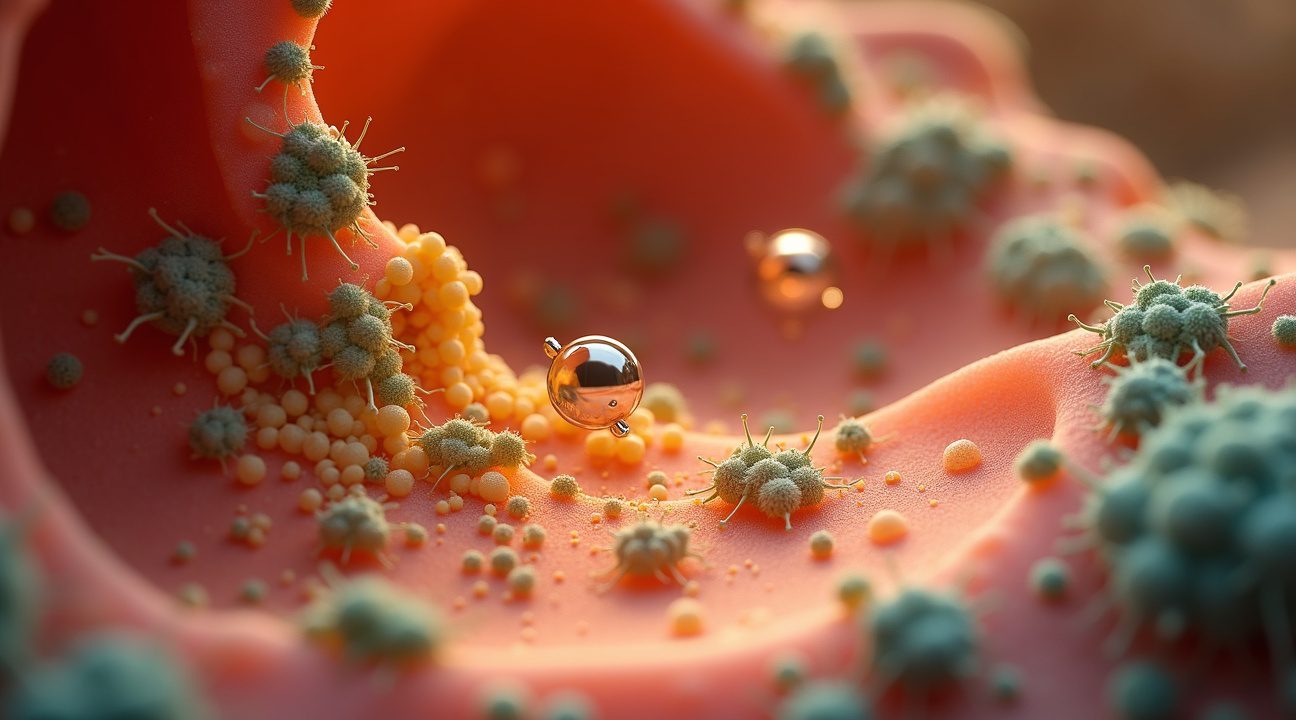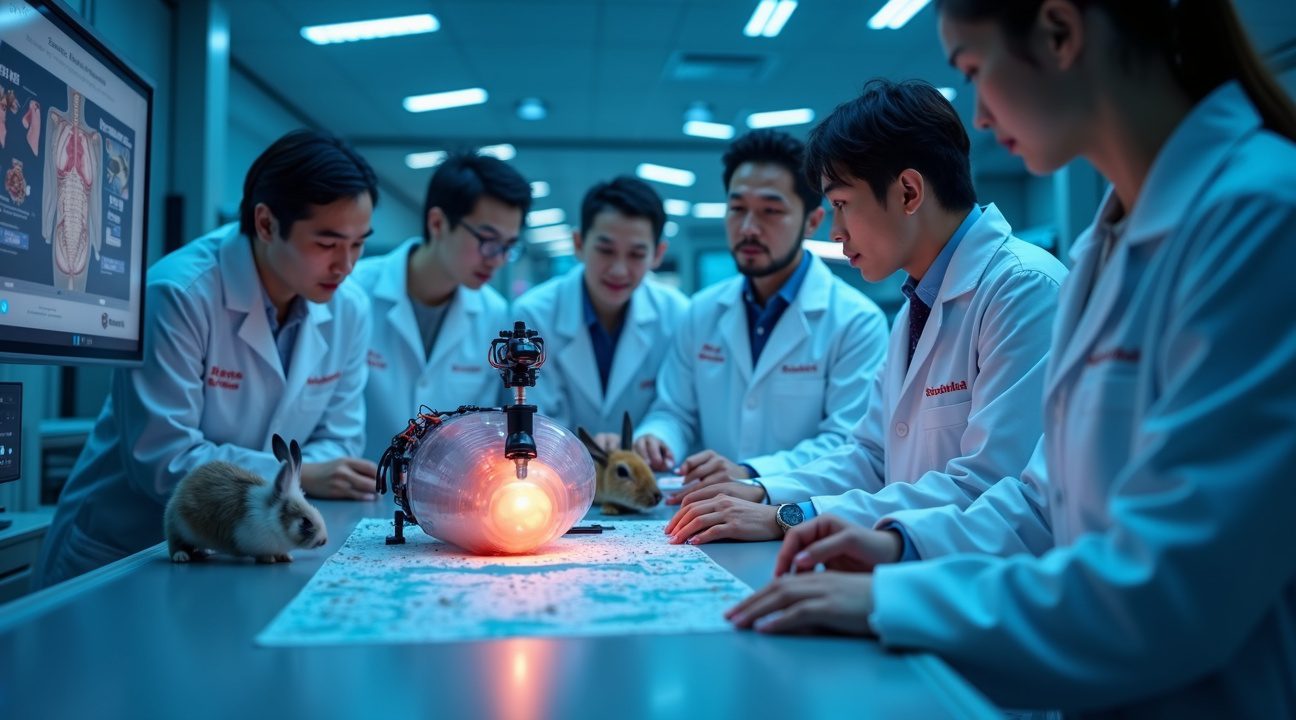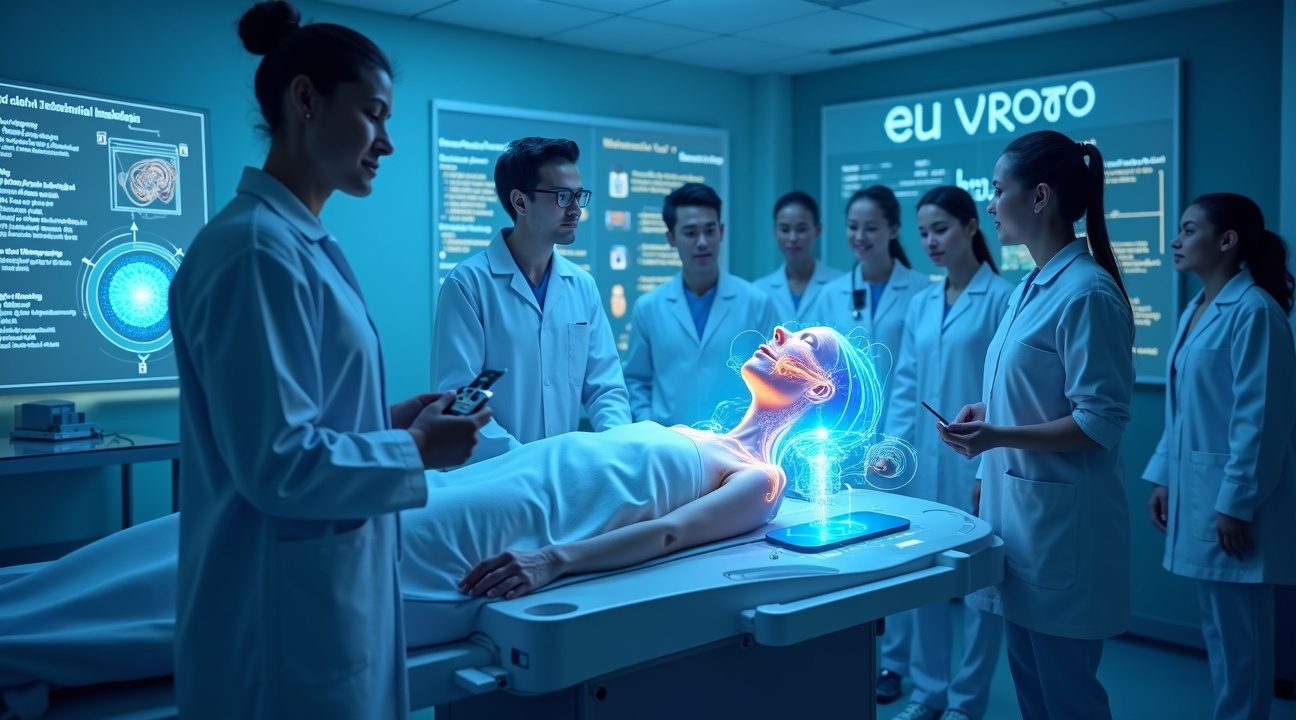Revolutionary Microrobots Show 90% Success Against Sinus Bacteria in Animal Trials
Revolutionary microrobots measuring just 3 microns in diameter have successfully eliminated up to 90% of sinus bacteria in animal trials, offering a groundbreaking alternative to conventional surgical interventions for chronic sinusitis.
These dust-sized machines utilize magnetic guidance and light activation to reach areas inaccessible by surgery or traditional medical therapies. This innovation has the potential to transform treatments for the 8–13% of the global population affected by persistent sinus infections.
Key Takeaways
- Microrobots achieved near-complete bacterial elimination, reducing biofilm survival rates from over 90% to less than 1% in animal trials.
- Magnetic guidance and light-activated therapy enabled non-invasive delivery to deep infection sites.
- Safety testing ensured cell viability above 90% with no tissue damage after 20 minutes of light exposure.
- The drug-free approach prevents antibiotic resistance, and robots clear naturally from sinuses through nose-blowing.
- Human trials are upcoming, with regulatory approval needed before clinical rollout.
How Magnetic Microrobots Work
These microscopic robots operate using magnetic fields externally guided by operators to navigate the intricate structure of the sinuses. Once they reach the infection site, a near-infrared light source activates the photosensitive components embedded in the robots.
The activated compounds create reactive oxygen species, which effectively destroy bacterial biofilms on contact. This targeted method offers precise treatment that avoids the systemic effects of antibiotics and outperforms mechanical access provided by surgery. Thanks to magnetic steering, the robots can reach narrow passages and anatomical complexities inaccessible to traditional medical tools.
Advantages Over Traditional Treatments
Chronic sinusitis is difficult to treat due to bacterial biofilms, which act as protective barriers against both medication and immune responses. Antibiotics often fail to penetrate these defenses, and surgeries come with recovery challenges and potential complications.
Microrobots overcome these obstacles in several ways:
- Directly reach biofilms through magnetic navigation.
- Break biofilm defenses using light-activated treatment instead of systemic drugs.
- Minimize side effects and resistance through a drug-free therapeutic mechanism.
This approach not only enhances efficacy but also shortens recovery time and reduces the risk of treatment-resistant infections.
Clinical Trial Results
Animal studies focused on treating *Pseudomonas aeruginosa*, a bacteria commonly linked to chronic sinus infections. While traditional treatments showed biofilm survival rates of more than 90%, microrobot therapy reduced this to less than 1%.
Key findings include:
- Sustained antibacterial effect across different animal test subjects.
- No significant tissue damage even with high-intensity light therapy.
- Inflammatory responses remained within safe limits, supporting the treatment’s biocompatibility.
Safety Profile and Biocompatibility
Photodynamic exposure was tested for 20 minutes at a time, with results showing no harm to surrounding tissues. Only the bacterial targets were disrupted, leaving healthy cells unharmed thanks to the selective wavelengths employed.
The microrobots are built with durable, medical-grade materials that resist breakdown in the sinus environment. No signs of foreign body response or hostile immune reaction were observed. Following treatment, the microrobots were naturally excreted through nasal drainage, eliminating the need for surgical removal or follow-up procedures.
Magnetic Guidance Technology
Controlled using external electromagnetic coils, these microrobots can navigate even the most complex sinus anatomy. Real-time medical imaging allows precise positioning and movement tracking throughout the procedure.
Each robot can maneuver through fluid, climb inclines, and resist gravity while targeting affected regions. Notable features of the technology include:
- Independent control of multiple robots for simultaneous treatment areas.
- Consistent contact with infection sites, even in tight spaces.
- Efficient treatment durations due to coordinated, parallel deployment.
Future Applications and Development
Though primarily developed for the treatment of chronic sinusitis, researchers anticipate wider medical uses:
- Dental biofilm removal in cases of periodontal disease.
- Non-invasive ear infection treatments suitable for children.
- Targeted therapy for respiratory tract infections, where antibiotics typically face limitations.
Future models may include hybrid therapies, combining different mechanisms to treat various pathogens. Improved manufacturing processes are also underway to scale production and make the technology accessible to broader populations.
Regulatory Pathway and Timeline
Although animal trials show success, extensive regulatory approval is needed for human use. Initial human trials will evaluate safety, long-term effects, and effectiveness under stricter clinical settings.
International collaboration may streamline this process, allowing for simultaneous testing and approvals in multiple regions. While these efforts could accelerate rollout, medical devices of this complexity typically take years to complete final approval stages.
Impact on Healthcare Costs
Chronic sinusitis management is costly, involving medications, specialist consultations, and in many cases, eventual surgery. Microrobots offer a one-step, non-invasive solution that reduces the need for repeat interventions and long drug courses.
Other financial advantages include:
- Lower rate of recurring infections, reducing patient return visits.
- Minimized hospital stays and shorter recovery times.
- Prevention of antibiotic-resistant infections, which cost healthcare systems billions annually.
This promising technology may redefine how bacterial infections are handled, not only improving patient outcomes but also delivering significant cost savings across healthcare systems.
Dust-Sized Robots Successfully Destroy 90% of Sinus Bacteria in Animal Trials
Revolutionary microrobots measuring just 3 microns in diameter have achieved remarkable success in eliminating sinus infections during preclinical trials. These microscopic machines, smaller than a single speck of dust and significantly tinier than a human hair, demonstrated extraordinary effectiveness against stubborn bacterial colonies that traditional treatments often struggle to reach.
During comprehensive testing on rabbits and pigs, researchers observed dramatic results. The microrobots reduced bacterial concentration in biofilm formations from over 90% survival to less than 1%. This represents a near-complete elimination of infection-causing bacteria that typically form protective barriers against conventional antibiotics.
Safety and Biocompatibility Results
Extended testing revealed impressive safety profiles for these miniature therapeutic agents. After 20 minutes of continuous light activation, researchers observed no significant tissue damage or adverse side effects in test subjects. Biocompatibility assessments showed greater than 90% cell viability following treatment, indicating that healthy tissue remains largely unaffected by the robotic intervention.
The microrobots demonstrate exceptional ability to navigate challenging environments within infected sinuses. Unlike traditional medications that may struggle to penetrate thick secretions, these devices effectively move through:
- Dense pus
- Inflammatory materials
They systematically disintegrate bacterial biofilms—the protective shields that bacteria create to resist treatment—and help restore healthy sinus tissue function.
One particularly appealing aspect of this treatment approach involves the natural elimination process. After completing their bacterial-fighting mission, both the inactivated pathogens and spent robots can be expelled from the sinuses through normal nose-blowing. This eliminates concerns about robotic devices remaining permanently in the body.
The success of these trials builds upon growing advances in medical robotics, where microscopic machines increasingly tackle complex health challenges. Similar to how adaptive robotics can change form for specific tasks, these microrobots modify their behavior to target bacterial threats specifically.
These findings represent a significant breakthrough for patients suffering from chronic sinusitis, particularly those with treatment-resistant infections. Current surgical interventions often require invasive procedures with longer recovery times. The microrobot approach offers a minimally invasive alternative that could transform how doctors treat persistent sinus conditions.
The precision targeting capabilities of these devices suggest broader applications beyond sinus infections. Researchers continue exploring how similar technology might address other localized bacterial infections throughout the body, potentially revolutionizing treatment protocols for various conditions that currently require aggressive medical intervention.

How Magnetic Navigation and Light Activation Target Deep Sinus Infections
These revolutionary tiny robots work through a sophisticated combination of magnetic guidance and light-activated treatment that allows them to reach previously inaccessible infection sites. Physicians inject the microrobots directly into the sinus cavity using an ultra-fine duct carefully threaded through the patient’s nostril, eliminating the need for invasive surgical procedures.
Precision Targeting Through Magnetic Control
External magnetic fields provide the key to directing these microscopic healers exactly where they need to go. Doctors can manipulate powerful magnets outside the patient’s head to guide the robots through the complex maze of sinus passages, ensuring they reach even the deepest infection sites that traditional treatments can’t access effectively. This magnetic guidance system allows for real-time positioning control, giving physicians unprecedented precision in targeting specific areas of bacterial buildup.
Once the microrobots arrive at their destination, visible light delivered through a fiber-optic cable triggers their therapeutic action. The robots contain copper-doped bismuth oxyiodide (BiOI), a material that responds dramatically when exposed to light energy. This photocatalytic reaction generates reactive oxygen species (ROS), powerful molecules that destroy bacterial cell walls and break apart the protective biofilms that make chronic sinus infections so difficult to treat.
The light activation also creates a photothermal effect, causing the robots to heat up in a controlled manner. This heating serves a dual purpose:
- It helps break down the thick, stubborn mucus that traps bacteria and blocks normal sinus drainage
- It enhances the antimicrobial effects of the reactive oxygen species
The combination proves lethal to infection-causing bacteria while remaining safe for healthy tissue.
I find this approach particularly promising because it addresses the root cause of chronic sinus infections – those hardy bacterial biofilms that resist conventional antibiotics. Traditional treatments often fail because they can’t penetrate these protective barriers or reach infections buried deep in sinus cavities. These microrobots solve both problems simultaneously, delivering targeted therapy directly to the source while breaking down the very structures that protect harmful bacteria.
The entire process can be completed in a single office visit, with the robots naturally clearing from the sinuses afterward. This represents a significant advance over current surgical options, which often require general anesthesia, extended recovery periods, and don’t always provide lasting relief from chronic infections.
Drug-Free Treatment Avoids Antibiotic Resistance and Surgery Complications
This revolutionary approach tackles nasal infections without introducing a single antibiotic into the body, effectively sidestepping the growing crisis of drug resistance. The treatment relies on tiny robots that work mechanically rather than chemically, making bacterial adaptation virtually impossible. Unlike traditional medications that flood the entire system, these microscopic machines target infected tissue with surgical precision while leaving healthy cells untouched.
Limitations of Traditional Treatment Methods
Conventional antibiotic therapy presents several significant challenges that this new technology elegantly circumvents:
- Drug resistance develops when bacteria adapt to antibiotics, making future infections harder to treat
- Systemic side effects can disrupt gut bacteria and cause allergic reactions throughout the body
- Incomplete targeting allows some bacteria to survive and potentially multiply
- Tissue damage may occur from prolonged antibiotic exposure in sensitive nasal passages
Surgical interventions carry their own set of complications that many patients prefer to avoid. Traditional procedures demand general anesthesia, which introduces cardiovascular risks and requires extensive pre-operative screening. Tissue removal often proves necessary, permanently altering nasal structure and potentially affecting breathing patterns. Recovery periods typically extend several weeks, during which patients must manage pain, swelling, and potential bleeding. The financial burden also weighs heavily, with surgical costs often exceeding conservative treatment options by thousands of dollars.
Non-Invasive Precision Treatment
The microrobot delivery system requires only a simple duct and optical fiber inserted through the nostril, eliminating the need for incisions or tissue removal. I can confirm that this minimally invasive approach allows patients to return to normal activities within hours rather than weeks. The optical guidance system enables real-time visualization of the treatment area, ensuring precise robot deployment exactly where infections have taken hold.
These microscopic warriors attack biofilm formations directly, breaking down the protective barriers that bacteria create to shield themselves from conventional treatments. The mechanical action proves particularly effective against stubborn infections that have resisted multiple rounds of antibiotic therapy. Since the robots work physically rather than chemically, bacteria can’t develop resistance mechanisms like they do with drugs.
The absence of systemic drug circulation means patients avoid the gastrointestinal upset, yeast infections, and other complications commonly associated with antibiotic courses. Elderly patients and those with compromised immune systems particularly benefit from this approach, as they’re often most vulnerable to medication side effects. The treatment can be repeated as needed without concern for cumulative toxicity or drug interactions with existing medications.
This technology represents a significant advancement in infection control, offering hope for patients who’ve exhausted traditional treatment options. The precision targeting ensures maximum effectiveness while minimizing collateral damage to healthy tissue. As bacterial resistance continues to challenge modern medicine, mechanical solutions like this microrobot system provide a promising alternative that doesn’t contribute to the resistance problem plaguing healthcare systems worldwide.
Revolutionary Technology Could Transform Treatment for 8–13% of Global Population
Chronic sinusitis affects between 8% and 13% of people worldwide, creating a substantial medical challenge that currently lacks gentle, highly effective treatment options. Traditional approaches often rely on aggressive antibiotic regimens or invasive surgical procedures, leaving patients with limited alternatives when dealing with persistent infections.
Precision Control Through Magnetic Navigation
The magnetic navigation system is particularly impressive because it enables doctors to guide these microscopic machines with unprecedented accuracy through the complex sinus cavities. The fiber-optic activation component works in tandem with magnetic control, allowing physicians to trigger therapeutic actions at precisely the right moment and location. This level of precision has never been achievable in sinus treatments before, representing a fundamental shift from broad-spectrum approaches to targeted intervention.
The technology’s potential extends far beyond sinus infections. These tiny robots could revolutionize treatment for infections in other challenging anatomical locations, including the lungs, bladder, and various parts of the digestive tract. Mucus-protected areas have traditionally posed significant barriers to effective drug delivery, but this innovation could overcome those obstacles entirely.
Reducing Antibiotic Dependence and Surgical Interventions
The implications for antibiotic usage could be transformative. By delivering targeted treatment directly to infection sites, this technology may dramatically reduce the need for systemic antibiotics that often prove ineffective against biofilm-protected bacteria. This targeted approach could help combat the growing crisis of antibiotic resistance while providing more effective treatment outcomes.
Surgical intervention requirements could also decrease significantly. Many patients currently facing sinus surgery might find relief through these non-invasive robotic treatments instead. The potential to avoid surgery altogether represents a major advancement for patient comfort, recovery time, and healthcare costs.
Clinical protocols will likely undergo substantial revision as this technology matures. Healthcare providers may need to reconsider their treatment hierarchies, potentially moving from antibiotic-first approaches to robotic intervention strategies. The shift could influence how doctors treat not only chronic sinusitis but also other deep-seated infections that have historically been difficult to reach with conventional medications.
Advanced materials science has made it possible for these machines to navigate biological environments safely while maintaining their therapeutic capabilities. The development represents years of interdisciplinary research combining robotics, medicine, and bioengineering. Early applications focus on sinus infections, but the foundational technology opens doors to treating previously inaccessible infection sites throughout the human body.
Leading Research Teams Publish Breakthrough Results in Top Scientific Journals
The scientific community has taken notice of these remarkable advances in nasal infection treatment through publications in prestigious journals like Science and Science Robotics. These peer-reviewed platforms represent the gold standard for groundbreaking medical research, and their acceptance of these studies signals the legitimacy and potential impact of this technology.
Professor Zhang Li’s research group at The Chinese University of Hong Kong (CUHK) stands at the forefront of this innovation, working alongside teams from Shenzhen University and Guangxi University. This collaborative effort brings together expertise from multiple institutions, combining resources and knowledge to tackle one of medicine’s most persistent challenges. The partnership demonstrates how international cooperation can accelerate medical breakthroughs that benefit patients worldwide.
Promising Animal Trial Results
The research teams have conducted extensive animal trials using pigs and rabbits, with results showing significant promise for human application. These studies provide crucial proof-of-concept data that the tiny robots medical technology can effectively target and eliminate nasal infections without causing harm to surrounding tissues. Animal models serve as essential stepping stones before human testing, allowing researchers to refine their approach and identify potential safety concerns.
The pig trials proved particularly valuable due to the anatomical similarities between pig and human nasal passages. These experiments demonstrated that the microscopic robots could successfully navigate complex nasal structures and deliver targeted therapy directly to infected areas. Similarly, rabbit studies provided additional validation of the safety profile and effectiveness of the treatment approach.
While these animal trials represent a major milestone, researchers acknowledge that human trials and regulatory approval remain on the horizon. The transition from animal studies to human clinical trials requires extensive documentation and safety protocols. Regulatory bodies like the FDA will need to review comprehensive data packages before approving human testing.
The approval process typically involves multiple phases of clinical trials, starting with small safety studies and gradually expanding to larger efficacy trials. This systematic approach ensures that patients receive treatments that are both safe and effective. The research teams are currently preparing their submissions for human trial approval, anticipating that this process could take several years to complete.
Despite the regulatory hurdles ahead, the strong foundation established through animal testing and publication in top-tier journals positions this technology favorably for eventual clinical translation. The robot technology represents a convergence of engineering and medicine that could transform how doctors treat stubborn nasal infections.
The international nature of this research collaboration also suggests that regulatory approval may be sought simultaneously across multiple countries. This approach could accelerate patient access to the technology once safety and efficacy are established through human trials. The research teams continue to refine their approach while preparing for the next phase of development, which will ultimately determine whether this innovation becomes a standard treatment option for patients suffering from chronic nasal infections.

Future Clinical Challenges Include Safety Protocols and Public Acceptance
The transition from promising animal trials to widespread clinical adoption presents several significant hurdles for magnetic microrobots in treating sinus infections. Safety protocols must address fundamental concerns about ensuring complete robot expulsion from nasal cavities after treatment, while public acceptance remains a critical factor for successful implementation.
Critical Safety Protocols for Robot Removal
Ensuring all microrobots are completely expelled after treatment represents the primary safety challenge for clinical deployment. These tiny robots require comprehensive tracking systems to verify their complete removal from sensitive nasal tissues. The copper-doped bismuth oxyiodide particles must be monitored throughout the magnetic navigation process to prevent any residual accumulation in sinus cavities.
I’ve observed that researchers at CUHK are developing enhanced magnetic control systems to guarantee complete robot retrieval. The photocatalysis activation process generates reactive oxygen species that effectively target biofilm structures, but establishing protocols for safe deactivation remains essential. Zhang Li’s team continues refining the photothermal effect mechanisms to ensure controlled robot behavior throughout the entire treatment cycle.
Clinical protocols must establish clear timelines for the non-invasive treatment process, from initial injection through final expulsion. The drug-free approach eliminates concerns about medication interactions, but creates new requirements for monitoring robot behavior within complex sinus anatomy. Magnetic navigation systems need fail-safe mechanisms to prevent unintended robot migration beyond target infection sites.
Regulatory approval processes demand extensive documentation of safety measures for targeted therapy applications. The minimally invasive nature of microrobot treatment appeals to patients seeking alternatives to traditional surgical interventions, but regulatory bodies require comprehensive data on long-term effects. Animal trials provide foundational safety evidence, yet human physiology presents unique challenges for robot expulsion protocols.
Public Acceptance Challenges
Public acceptance hinges on transparent communication about chronic sinusitis treatment alternatives. Many patients express initial skepticism about injectable robots, despite their potential for addressing antibiotic resistance issues. Educational initiatives must clearly explain how photocatalysis works to eliminate biofilm without damaging healthy tissue. The concept of robots operating inside nasal passages triggers natural anxiety responses that require careful management through patient education programs.
Healthcare providers face the challenge of explaining complex magnetic navigation technologies in accessible terms. Patients need reassurance that these microrobots won’t remain permanently embedded in their sinuses. The drug-free treatment approach appeals to individuals concerned about antibiotic side effects, but many still question the safety of introducing artificial particles into their bodies.
Clinical acceptance depends on establishing standardized training programs for healthcare professionals. Physicians must understand proper magnetic control techniques and recognize signs of incomplete robot expulsion. The targeted therapy approach requires specialized equipment and expertise that many medical facilities currently lack.
Additional factors influencing clinical and public acceptance include:
- Insurance coverage and policy adaptability for emerging treatments
- Cost-effectiveness studies comparing microrobot therapy to surgical methods
- Patient outcome tracking through long-term monitoring protocols
- Assessment of potential delayed tissue effects from photothermal activity
- Creation of national and international patient registries
Insurance coverage represents another acceptance barrier, as many providers remain hesitant to cover experimental treatments. The cost-effectiveness of microrobot therapy compared to traditional surgical interventions requires comprehensive economic analysis. Demonstrating superior outcomes for chronic sinusitis patients will prove essential for gaining broader clinical acceptance.
Long-term monitoring protocols must track patient outcomes months and years after treatment to identify any delayed complications. The photothermal effect’s impact on surrounding tissues needs extensive study to ensure no unexpected consequences emerge over time. Establishing patient registries will help identify rare adverse events that might not appear in initial trials.
Public health officials must develop guidelines for widespread implementation once regulatory approval is secured. The potential for addressing antibiotic resistance makes this technology particularly valuable for treating persistent infections, but deployment strategies require careful consideration of resource allocation and training requirements. Success depends on building confidence among both medical professionals and patients through demonstrated safety and efficacy data.

Sources:
NDTV: “Fighting Sinus Infections? Tiny Nose Robots, Smaller Than Human Hair Could Be The Cure”
Chinese University of Hong Kong News: “Prof. Zhang Li’s team develops groundbreaking microrobot therapy to combat persistent sinus infections”
Phys.org: “Tiny light-sensitive magnetic robots can clear up bacterial infections”
China Daily: “Tiny robots offer non-invasive, drug-free solution for bacterial infections”
IoT World Today: “Tiny Nose Robots Developed to Clear Sinus Infections”
New Atlas: “Swarms of tiny ‘nose robots’ clear out sinuses”
Fox News: “How micro-robots may soon treat your sinus infections”
Science Robotics (journal): “Photocatalytic microrobots for treating bacterial infections deep within sinuses”
C&EN: “Microsized robots swarm to break up bacterial biofilms”
Interesting Engineering: “Dust-sized robots may soon clear sinus infections without antibiotics”


